Comments / Questions (23)
![]() Elly De Hooge wrote:
Elly De Hooge wrote:
Goeden middag, kun je bv dit fair isle patroon ook op een boven naar beneden breien manier gebruiken. Dus ipv minderen de steken meereden? Vr.gr Elly
29.03.2024 - 13:15DROPS Design answered:
Dag Elly,
Ja, dat zou kunnen, dan doe je het precies andersom. Waar je normaal moet minderen, ga je meerderen etc.
10.04.2024 - 09:39
![]() Elvia wrote:
Elvia wrote:
Hello! Thank you for your lovely free patterns. I have joined the sleeves to the body. Knitting has become difficult at this point. Knitting gets tight when I reach the sleeves. Is this the expected? Do you have any suggestions that can make it easier? Thanks!!
13.11.2023 - 04:44DROPS Design answered:
Dear Elvia, the first rows might look a bit tricky but after some rows, it will work super fine again. You can get helped continuing working the sleeves on double pointed needles or on another circular needle for the first rows. Happy knitting!
13.11.2023 - 08:36
![]() Gerd Formofetten wrote:
Gerd Formofetten wrote:
Jeg strikker jakken rundt med oppklippsmasker. Får ikke mønsteret til å stemme. Str xl. Skal jeg telle med a2b rundt hele omgangen?
30.12.2021 - 07:43DROPS Design answered:
Hej Gerd. A.2B stickar du kun en gang på omgangen (rett för de sista 5 stolpemaskerna). Du har 351 m. 5 + (17xA.2A) + A.2B + 5 = 351 m. Mvh DROPS Design
04.01.2022 - 14:39
![]() Carole wrote:
Carole wrote:
Is this pattern available in kid sizes? Thank you
29.11.2021 - 14:41DROPS Design answered:
Dear Carole, not exactly the same - find our nordic patterns of jackets for children here. Happy knitting!
29.11.2021 - 15:47
![]() Cecillia wrote:
Cecillia wrote:
Hi! What are the measurement (S, M, L) for the finished garment? I can't find it.
05.07.2021 - 06:56DROPS Design answered:
Dear Cecillia, you will find all finished measurements for each size in the chart at the end of the patttern - measure a similar garment you have and like the shape to find ou the matching size - read more here. Happy knitting!
05.07.2021 - 08:35
![]() Susanne Johnsen wrote:
Susanne Johnsen wrote:
Hej. Er lige begyndt på mønster og kan ikke finde ud af om den ekstra maskebi mønster A1B skal sluttes af på pinden, eller man skal starte med den i næste pind. Kan ikke få mønsteret til at passe. Vh Susanne strikker str XXXL
21.04.2021 - 08:29DROPS Design answered:
Hej Susanne, jo, det er for at få mønsteret ens i hver side mod midt foran. Når du slutter med den ene maske i venstre side, så starter du også med den når du strikker tilbage igen :)
28.04.2021 - 15:37
![]() Régine Plessis wrote:
Régine Plessis wrote:
Je réalise ce modèle en taille Médium. Je suis arrivée à une hauteur de 36cm pour les devants et le dos pour faire les emmanchures et d'après le schéma il est indiqué une hauteur de 60 cm. Est- une erreur? Que dois-faire? Je vous remercie. Régine
05.02.2021 - 17:18DROPS Design answered:
Bonjour Regine, le gilet mesure environ 60 cm de hauteur totale depuis l'épaule. Dans la taille M vous commencez a faire les emmanchures à une hauteur de 36 cm. Comment lire le schéma des mesures vous trouverez ICI. Bon tricot!
05.02.2021 - 17:55
![]() Claire Wauthy wrote:
Claire Wauthy wrote:
Bonjour, je réalise ce gilet en taille M. pouvez-vous confirmer qu’il y a 0 diminutions à fait à la fin du diagramme A1A ou bien est-ce une erreur de frappe ? Je vous remercie. Claire
30.07.2020 - 02:52DROPS Design answered:
Bonjour Mme Wauthy, aucune faute de frappe: vous tricotez: 5 m de bordure devant, 30 fois A.1A (= 30 fois 10 m), A.1B (= 1 m) et 5 m de bordure devant = 5+30x10 +1 +5= 311 m. Bon tricot!
30.07.2020 - 09:14
![]() Sunniva wrote:
Sunniva wrote:
A2b fra vrangsiden... skal den strikkes først eller sist?
14.02.2020 - 08:02DROPS Design answered:
Hej Sunniva, du strikker samme mønster men fra modsat side (altså i modsat rækkefølge) som du ser selve mønsteret i diagrammet fra retsiden. God fornøjelse!
14.02.2020 - 11:47
![]() Emma wrote:
Emma wrote:
Hej. På bilden ser det ut som att de fem framkantmaskorna på vissa ställen är blåa. Enligt vad jag förstår av mönstret skickas de fem framkantmaskorna alltid i vit färg. Har jag missat något? :)
10.07.2019 - 23:05DROPS Design answered:
Hei Emma. Du strikker stolpene i samme farge som resten av omgangen. God fornøyelse
11.07.2019 - 12:49
Periwinkle Jacket#periwinklejacket |
|||||||||||||
 |
 |
||||||||||||
Knitted jacket with round yoke, multi-coloured Norwegian pattern and A-shape. Size: S - XXXL Piece is knitted in DROPS Merino Extra Fine.
DROPS 191-29 |
|||||||||||||
|
INFORMATION FOR PATTERN: GARTER STITCH (back and forth): 1 ridge = knit 2 rows. PATTERN: See diagrams A.1 and A.2. Choose diagram for your size. Diagrams show all rows in pattern seen from the right side. DECREASE TIP-1 (evenly): To calculate how to decrease evenly, use the total number of stitches on row (e.g. 211 stitches), minus bands (e.g. 10 stitches) and divide the remaining stitches by number of decreases to be done (e.g. 10) = 20.1. In this example decrease by knitting approx. every 19th and 20th stitch together. Do not decrease over bands. DECREASE TIP-2 (applies to sides of body): All decreases are done from the right side! Begin 5 stitches before marker thread in the side, knit 2 together, knit 6 (marker thread is in the middle of these 6 stitches), slip 1 stitch knitwise, knit 1, pass slipped stitch over stitch worked (= 2 stitches decreased). INCREASE TIP (applies to mid under sleeve): Begin 2 stitches before marker thread, make 1 yarn over, knit 2 (marker thread is in the middle of these 2 stitches), make 1 yarn over (= 2 stitches increased). On next round knit yarn overs twisted to avoid holes. KNITTING TIP-1 (applies to bands): When working pattern border with two colours on yoke, also work with base colour in pattern border over the 5 band stitches in each side. KNITTING TIP-2: To avoid the knitting tension to tighten when working pattern, it is important not to tighten the strands on back side of piece. Use a larger needle size when working pattern if needed. BUTTONHOLES: Decrease for buttonholes on right band (when garment is worn): 1 buttonhole = knit second and third stitch from edge together and make 1 yarn over. On next row (wrong side) knit the yarn over to make a hole. Decrease for buttonholes when piece measures: S: 3, 11, 19, 26, 34, 41, 49 and 56 cm M: 3, 11, 19, 27, 35, 43, 51 and 58 cm L: 3, 12, 20, 28, 36, 44, 52 and 60 cm XL: 3, 12, 20, 29, 37, 46, 54 and 62 cm XXL: 3, 11, 19, 26, 34, 42, 49, 57 and 64 cm. XXXL: 3, 11, 19, 27, 35, 43, 51, 59 and 66 cm. NOTE! Decrease the last of the 8-8-8-8-9-9 buttonholes approx. in the middle of neck edge. ---------------------------------------------------------- JACKET: Body is worked back and forth on circular needle from mid front, bottom up. Sleeves are worked in the round on double pointed needles/a short circular needle, bottom up. Then slip body and sleeves together and work yoke back and forth on circular needle from mid front until finished measurements. An elevation in the back of neck can be worked to get a better fit so that yoke is somewhat higher in the neck. This elevation can be skipped, to make the neck the same at the front and back - see explanation on elevation in pattern. BODY: Cast on 211-231-249-269-295-323 stitches (including 5 band stitches in each side towards mid front) on circular needle size 3 mm with light grey blue. Work rib as follows: ROW 1 (= right side): Knit all stitches. ROW 2 (= wrong side): Knit 5, * purl 1, knit 1 *, work from *-* until 6 stitches remain on row, purl 1 and finish with knit 5. Repeat 1st and 2nd row until rib measures 3 cm. Switch to circular needle size 4 mm. Knit 1 row from right side while decreasing 10-10-12-12-14-14 stitches evenly - read DECREASE TIP-1 and remember BUTTONHOLES on right band - see explanation above = 201-221-237-257-281-309 stitches. Insert 1 marker thread 53-58-62-67-73-80 stitches in from each side = 95-105-113-123-135-149 stitches between marker threads on back piece and move marker thread upwards when working. Purl 1 row from wrong side (knit bands). Then work in stocking stitch back and forth with 5 band stitches in GARTER STITCH - see explanation above, in each side towards mid front. REMEMBER THE KNITTING TENSION! When piece measures 8 cm, decrease 1 stitch on each side of both marker threads - read DECREASE TIP-2 (= 4 stitches decreased). Decrease like this every 8 cm 4 times in total in each side = 185-205-221-241-265-293 stitches. Work until piece measures approx. 36 cm in all sizes. Work next row as follows from right side: Knit 45-50-53-58-63-69 (= front piece), cast off 8-8-10-10-12-14 stitches for armhole, knit 79-89-95-105-115-127 (= back piece), cast off 8-8-10-10-12-14 stitches for armhole and knit the remaining 45-50-53-58-63-69 stitches (= front piece). Put piece aside and work the sleeves. SLEEVE: Cast on 44-46-48-52-52-54 stitches on double pointed needles size 3 mm with light grey blue. Work rib as follows: ROUND 1: Knit all stitches. ROUND 2: * Knit 1, purl 1 *, repeat from *-* the entire round. Repeat 1st and 2nd round until rib measures 3 cm. Switch to double pointed needles size 4 mm. Insert 1 marker thread at beginning of round (= mid under sleeve) and move the marker thread upwards. Work in stocking stitch in the round. When piece measures 9-7-9-7-9-7 cm, increase 2 stitches mid under sleeve - read INCREASE TIP. Increase like this every 3½-3-2-2-1½-1½ cm 11-13-16-17-19-20 times in total (switch to a short circular needle when there are enough stitches) = 66-72-80-86-90-94 stitches. Continue until sleeve measures 46-45-43-41-40-38 cm (shorter measurements in the larger sizes because of wider neck and longer yoke). Work next round as follows: Cast off 4-4-5-5-6-7 stitches, knit 58-64-70-76-78-80 stitches and cast off the remaining 4-4-5-5-6-7 stitches. Put piece aside and knit another sleeve the same way. YOKE: Slip sleeves on to same circular needle as body where armholes were cast off = 285-317-341-373-397-425 stitches. NOW MEASURE THE PIECE FROM HERE! Read KNITTING TIP-1 AND KNITTING TIP-2! Continue with light grey blue and purl 1 row from wrong side but knit the bands. Knit 1 row from right side while decreasing 4-6-0-2-6-4 stitches evenly = 281-311-341-371-391-421 stitches. Work in stocking stitch back and forth with 5 band stitches in garter stitch in each side towards mid front. When piece measures 1-2-3-3-4-6 cm from where body and sleeves were put together, work next row as follows from right side: 5 band stitches in garter stitch, work A.1A until 6 stitches remain on row (= 27-30-33-36-38-41 repetitions of 10 stitches), work A.1B (= 1 stitch) and finish with 5 band stitches in garter stitch. Continue pattern like this. AT THE SAME TIME on row marked with arrow in A.1A decrease 10-0-10-20-20-30 stitches evenly = 271-311-331-351-371-391 stitches. NOTE! In size S and L decrease in the off white sections. Work next row as follows from right side: 5 band stitches in garter stitch, work A.2A until 6 stitches remain on row (= 13-15-16-17-18-19 repetitions of 20 stitches), work A.2B (= 1 stitch) and finish with 5 band stitches in garter stitch. Continue pattern like this and decrease as shown in A.2A. When A.2 has been worked, there are 141-161-171-181-191-201 stitches on needle. Now work elevation in the back of neck or start to work the neck edge if you do not want an elevation. ELEVATION IN BACK OF NECK: Skip this paragraph if you do not want an elevation. Insert 1 marker in the middle stitch on needle = mid back. Begin from right side with off white and knit 15-16-17-18-19-20 stitches past stitch with marker, turn, tighten yarn and purl 31-33-35-37-39-41. Turn, tighten yarn and knit 46-49-52-55-58-61, turn, tighten yarn and purl 61-65-69-73-77-81. Turn, tighten yarn and knit 76-81-86-91-96-101, turn, tighten yarn and purl the rest of row (knit band). NECK EDGE: Knit 1 row from right side with off white while decreasing 24-40-44-48-54-58 stitches evenly = 117-121-127-133-137-143 stitches. Purl 1 row (knit bands). Switch to circular needle size 3 mm and work rib from right side as follows: 5 band stitches in garter stitch, * knit 1, purl 1 *, work from *-* until 6 stitches remain, knit 1 and finish with 5 band stitches in garter stitch. Continue rib like this for 3 cm. Cast off stitches with knit over knit and purl over purl. Jacket measures approx. 58-60-62-64-66-68 cm from shoulder and down. ASSEMBLY: Sew the openings under the sleeves. Sew the buttons on to the left band. |
|||||||||||||
Diagram explanations |
|||||||||||||
|
|||||||||||||
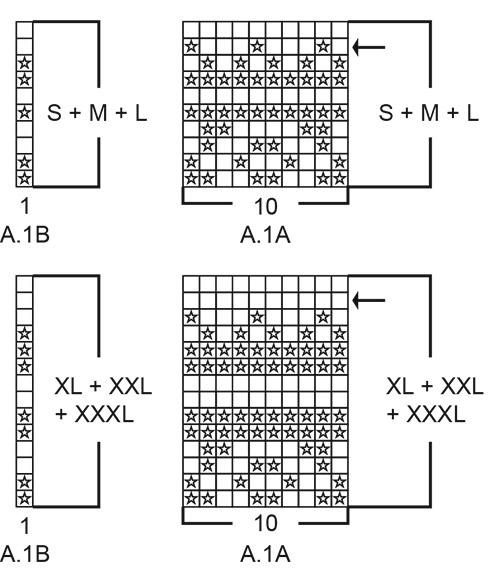
|
|||||||||||||
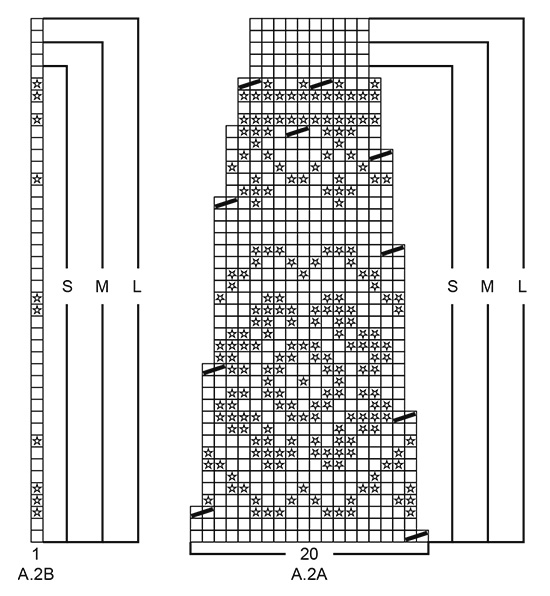
|
|||||||||||||

|
|||||||||||||
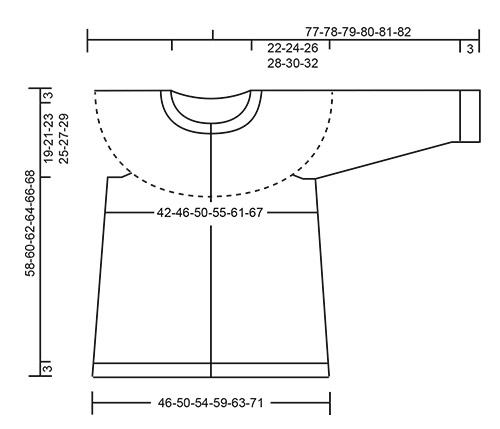
|
|||||||||||||
Have you finished this pattern?Tag your pictures with #dropspattern #periwinklejacket or submit them to the #dropsfan gallery. Do you need help with this pattern?You'll find 32 tutorial videos, a Comments/Questions area and more by visiting the pattern on garnstudio.com. © 1982-2025 DROPS Design A/S. We reserve all rights. This document, including all its sub-sections, has copyrights. Read more about what you can do with our patterns at the bottom of each pattern on our site. |
|||||||||||||







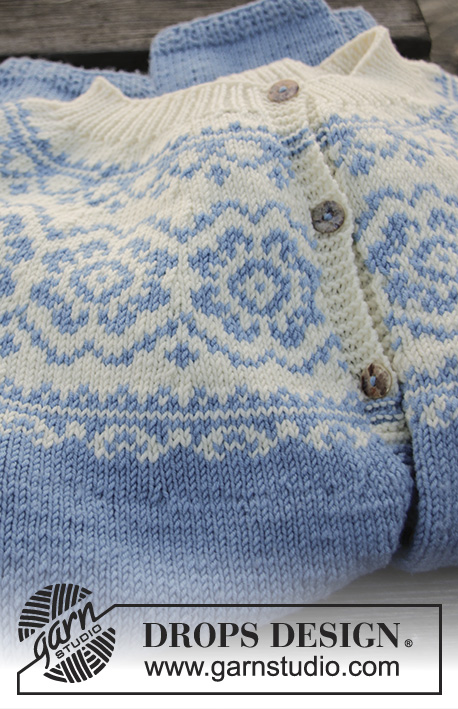
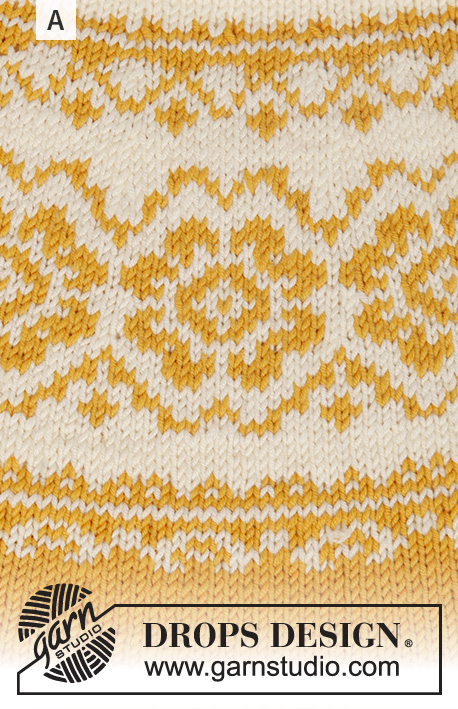
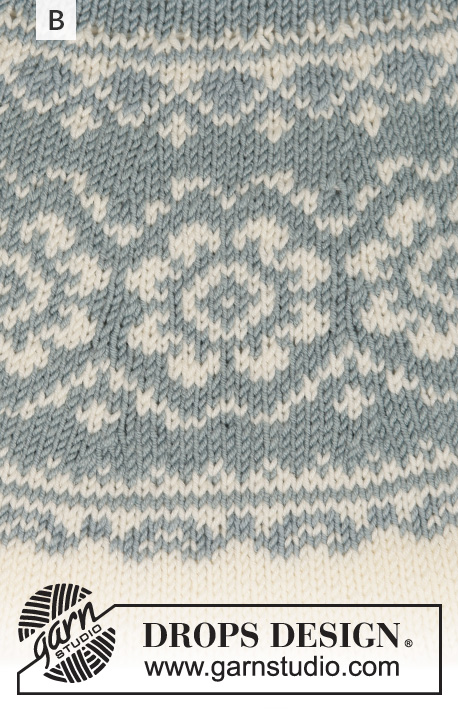

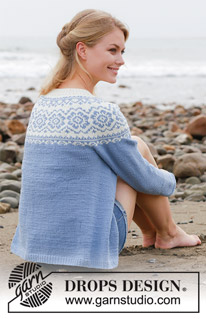

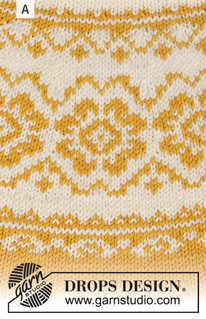
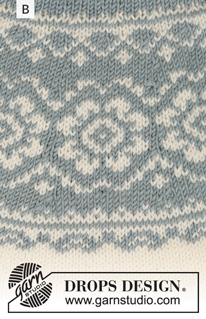








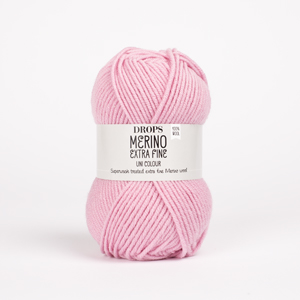
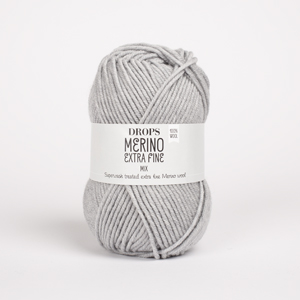

























































Post a comment to pattern DROPS 191-29
We would love to hear what you have to say about this pattern!
If you want to leave a question, please make sure you select the correct category in the form below, to speed up the answering process. Required fields are marked *.